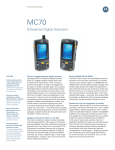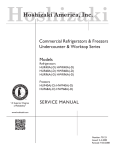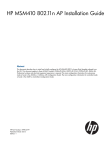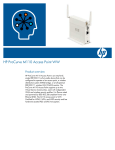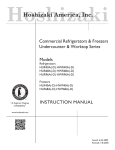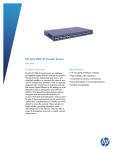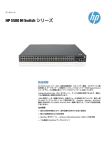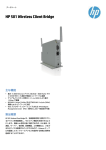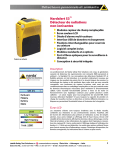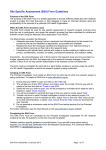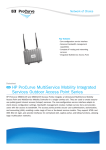Download Hewlett Packard Enterprise V-M200
Transcript
HP V-M200 802.11n Access Point Series Product overview Key features The HP V-M200 802.11n Access Point provides wireless connectivity for your expanding network. Take full advantage of the next-generation IEEE 802.11n standard with the V-M200 access point's dual-band capability while simultaneously supporting IEEE 802.11a or 802.11b/g devices. The new Web user interface makes the V-M200 access point easy to set up, yet retains key functionality to keep your sensitive data secure. b IEEE 802.11a/b/g/n access point b Single radio, dual band (2.4 GHz and 5 GHz) b Independently managed b Easy-to-use Web user interface b Powered by 802.3af PoE or included power supply Features and benefits Management • NEW Secure and easy-to-use Web UI: – Quick setup page: consolidates key settings into one page for simple and rapid configuration for common deployment scenarios – HTTPS secured management sessions: prevent management sessions from being observed on the network • Integration with HP PCM: enables discovery and mapping via HP PCM, available as a free download from the Web; provides all the basic tools needed to handle a network effectively, along with a 60-day trial version of HP PCM+ • IEEE 802.1AB Link Layer Discovery Protocol (LLDP): automated device discovery protocol provides easy mapping by network management applications • Manager, operator privilege levels: provides read-only (operator) and read-write (manager) access levels for Web management Connectivity • NEW Fully IEEE 802.11n-compliant dual-band access point: – 2.4 GHz frequency band support: uses your IEEE 802.11n wireless clients alongside legacy IEEE 802.11b/g devices – 5 GHz frequency band support: operates your IEEE 802.11n and 802.11a devices in the 5 GHz spectrum, which has less interference from microwave ovens, Bluetooth® devices, and cordless phones • IEEE 802.3af PoE-powered device (PD) option: simplifies deployment and dramatically reduces installation costs by helping to eliminate the time and cost involved in supplying local power at each access point location • Service-class segmentation: – Up to four SSIDs (one per wireless community): allows administrator to identify multiple service sets for clients to access – Up to four VLANs (one per wireless community): IEEE 802.1Q VLAN tagging provides security between workgroups – Wireless community-based prioritization: allows the administrator to help ensure that key network traffic is prioritized by weighting specific wireless communities • Auto Channel Select (ACS): helps reduce radio co-channel interference by automatically selecting an unoccupied radio channel • Wireless Distribution System (WDS) modes: – Access Point and WDS Bridge, Access Point Only, WDS Bridge Only, and Monitor: allow HP V-M200 802.11n Access Points to connect wirelessly to other HP V-M200 802.11n Access Points without a wired backbone; this is useful for extending the network across areas where no wired infrastructure exists • Interoperability: meets Wi-Fi Alliance certifications, including IEEE 802.11n Wi-Fi and WPA2 to help provide multivendor interoperability • Three external 3x3 MIMO omni-directional antennas: enable the antennas to be configured for improved radio coverage and performance • Quality of Service management: – IEEE 802.1p: maps WMM prioritization to IEEE 802.1p queues on the wired network – Wireless community-based prioritization: allows users to prioritize traffic based on wireless community (SSID) – DiffServ: prioritizes data based on the traffic class • Auto-MDIX: automatically adjusts for straight-through or crossover cables on the 10/100/1000 port • Spanning Tree Protocol (IEEE 802.1D): prevents network loops Mobility • Four wireless communities: consolidates Quality of Service, security, and VLAN settings into one easy-to-manage identifier per SSID 2 Security Monitor and diagnostics • AP client access control functions: • Diagnostic: – IEEE 802.1X authentication using EAP-SIM, EAP-FAST, EAP-TLS, EAP-TTLS, and PEAP – Client event log records association, authentication, and DHCP events – MAC address authentication using local or RADIUS access lists – Packet capture tool for Ethernet and IEEE 802.11 interfaces (PCAP format) – RADIUS AAA using EAP-MD5, PAP, CHAP, and MS-CHAPv2 – Data rate matrix – Remote SYSLOG – Layer 2 wireless client isolation • RADIUS-based MAC authentication: authenticates a wireless client with a RADIUS server based on the MAC address of the client; this is useful for clients with minimal or no user interface • Choice of IEEE 802.11i, Wi-Fi Protected Access 2 (WPA2), or WPA: locks out unauthorized wireless access by authenticating users prior to granting network access; robust Advanced Encryption Standard (AES) or Temporal Key Integrity Protocol (TKIP) encryption secures the data integrity of the wireless traffic • Secure Sockets Layer (SSL): encrypts all HTTP traffic, allowing secure access to the browser-based management interface of the access point Warranty and support • Lifetime warranty: for as long as you own the product with advance replacement and next-business-day delivery (available in most countries)* • Electronic and telephone support: limited electronic and telephone support is available from HP; refer to www.hp.com/networking/warranty for details on the support provided and the period during which support is available • Software releases: refer to www.hp.com/networking/warranty for details on the software releases provided and the period during which software releases are available for your product(s) • Local wireless bridge client traffic filtering: when enabled, prevents communication between wireless devices associated with the same access point • Closed system: restricts broadcast of SSID as a security measure to conceal presence of the wireless network; access point does not respond to the wireless client probe request of "ANY" • Management password: provides security so that only authorized access to the Web browser interface is allowed • Wired Equivalent Privacy (WEP) using 40 or 120 static or dynamic keys: provides backward compatibility for legacy clients • Rogue AP detection: identifies all access points in range; known or trusted access points can be saved, allowing network administrators to identify unauthorized access points *Hardware warranty replacement for as long as you own the product, with next business day advance replacement (available in most countries) with a five-year hardware warranty replacement for the disk drive included with HP AllianceONE Services zl Module, HP Threat Management Services zl Module, HP PCM+ Agent with AllianceONE Services zl Module, and HP E-MSM765 zl Mobility Controller. For details, refer to the HP Software License, Warranty, and Support booklet at www.hp.com/networking/warranty. 3 HP V-M200 802.11n Access Point Series Specifications HP V-M200 802.11n Access Point (US) (J9467A) HP V-M200 802.11n Access Point (WW) (J9468A) 1 RJ-45 auto-sensing 10/100/1000 port (IEEE 802.3 Type 10Base-T, IEEE 802.3u Type 100Base-TX, IEEE 802.3ab Type 1000Base-T); Media Type: Auto-MDIX; Duplex: 10Base-T/100Base-TX: half or full; 1000Base-T: full only 1 RJ-45 auto-sensing 10/100/1000 port (IEEE 802.3 Type 10Base-T, IEEE 802.3u Type 100Base-TX, IEEE 802.3ab Type 1000Base-T); Media Type: Auto-MDIX; Duplex: 10Base-T/100Base-TX: half or full; 1000Base-T: full only AP characteristics Radios Single (n/a/b/g) Single (n/a/b/g) Radio operation modes Client access, Packet capture, Client bridge Client access, Packet capture, Client bridge AP operation modes Autonomous Autonomous Wi-Fi Alliance Certification a/b/g/n Wi-Fi Certified a/b/g/n Wi-Fi Certified Physical characteristics Dimensions 5.04(d) x 7.68(w) x 1.26(h) in. (12.8 x 19.5 x 3.2 cm) 5.04(d) x 7.68(w) x 1.26(h) in. (12.8 x 19.5 x 3.2 cm) Weight 0.84 lb. (.39 kg) 0.84 lb. (.39 kg) Enclosure Indoor Indoor Environment Operating temperature 32°F to 104°F (0°C to 40°C) 32°F to 104°F (0°C to 40°C) Operating relative humidity 15% to 95% @ 104°F (40°C), non-condensing 15% to 95% @ 104°F (40°C), non-condensing Non-operating/Storage temperature -40°F to 158°F (-40°C to 70°C) -40°F to 158°F (-40°C to 70°C) Non-operating/Storage relative humidity 15% to 95% @ 149°F (65°C), non-condensing 15% to 95% @ 149°F (65°C), non-condensing Altitude up to 15,000 ft. (4.6 km) up to 15,000 ft. (4.6 km) Acoustic Power: 0 dB (no fan) Power: 0 dB (no fan) IEEE 802.3af PoE Compliant or included 110-240 V 50/60 Hz external power supply 1EEE 802.3af PoE Compliant or included 110-240 V 50/60 Hz external power supply Current 0.7 A 0.7 A Maximum power rating 8.4 W 8.4 W Antenna External 2.4/5 GHz 3x3 MIMO omni-directional antennas External 2.4/5 GHz 3x3 MIMO omni-directional antennas Number of external antennas 3 3 Ports Electrical characteristics Description Frequency band and Operating channels US 2.400 - 2.462 GHz (11 channels) 5.150 - 5250 GHz (4 channels) 5.725 - 5.825 GHz (5 channels) European Union 2.4 - 2.472 GHz (13 channels) 5.150 - 5.240 GHz (4 channels) Rest of World (Actual channels designated by selecting country in UI) 2.400 5.150 5.250 5.470 5.725 - 2.472 5.250 5.350 5.700 5.865 GHz GHz GHz GHz GHz (13 channels) (4 channels) (4 channels) (11 channels) (7 channels) Radio FCC Part 15.247; FCC Part 15.407 (no DFS) EN 300 328; EN 301-489-1; EN 301-489-17; EN 301 893 (EU) no DFS; RSS-210, Issue 7; RSS-Gen, Issue 2; NCCLP0002 (Taiwan) Safety UL 60950-1 UL 60950-1; CAN/CSA 22.2 No. 60950-1; IEC 60950-1; EN 60950-1 Emissions CISPR 22 Class B; EN 55022 Class B; EN 60601-1-2; ICES-003 Class B; IEC/EN 61000-3-2; IEC/EN 61000-3-3; FCC Part 15, Class B CISPR 22 Class B; EN 55022 Class B; EN 60601-1-2; ICES-003 Class B; IEC/EN 61000-3-2; IEC/EN 61000-3-3; FCC Part 15, Class B RF Exposure FCC Bulletin OET-65C RSS-102; EN 50385; EC Council Recommendation 1999/519/EC; ARPANSA EMR Limits (May 2002) Features Single Radio IEEE 802.11n for high-throughput applications and IEEE 802.11a/b/g for legacy support - IEEE 802.11a/b/g/n Wi-Fi Certified (dual streams) - Dual-band support (2.4 and 5 GHz) Single Radio IEEE 802.11n for high-throughput applications and IEEE 802.11a/b/g for legacy support - IEEE 802.11a/b/g/n Wi-Fi Certified (dual streams) - Dual-band support (2.4 and 5 GHz) Services Refer to the HP website at www.hp.com/networking/services for details on the Refer to the HP website at www.hp.com/networking/services for details on the service-level descriptions and product numbers. For details about services and service-level descriptions and product numbers. For details about services and response times in your area, please contact your local HP sales office. response times in your area, please contact your local HP sales office. 4 HP V-M200 802.11n Access Point Series Specifications (continued) HP V-M200 802.11n Access Point (US) (J9467A) HP V-M200 802.11n Access Point (WW) (J9468A) Radio characteristics: IEEE 802.11n 5 GHz @ 40 MHz Data rate Receiver sensitivity Transmit power MCS0 Mbps -88 dBm 17 dBm MCS7 Mbps -70 dBm 12 dBm MCS8 Mbps -88 dBm 17 dBm MCS15 Mbps -69 dBm 12 dBm MCS7 Mbps -75 dBm 12 dBm MCS8 Mbps -92 dBm 17 dBm MCS15 Mbps -72 dBm 12 dBm MCS0 Mbps -94 dBm 19 dBm MCS7 Mbps -77 dBm 11 dBm MCS8 Mbps -94 dBm 19 dBm MCS15 Mbps -75 dBm 11 dBm 6 Mbps -92 dBm 17 dBm 54 Mbps -76 dBm 13 dBm 1 Mbps -94 dBm 19 dBm 11 Mbps -91 dBm 19 dBm 6 Mbps -92 dBm 17 dBm 54 Mbps -76 dBm 13 dBm IEEE 802.11n 5 GHz @ 20 MHz Data rate Receiver sensitivity Transmit power MCS0 Mbps -94 dBm 17 dBm IEEE 802.11n 2.4 GHz @ 20 MHz Data rate Receiver sensitivity Transmit power IEEE 802.11a Data rate Receiver sensitivity Transmit power IEEE 802.11b Data rate Receiver sensitivity Transmit power IEEE 802.11g Data rate Receiver sensitivity Transmit power Standards and protocols (applies to all products in series) Mobility IEEE 802.11a High Speed Physical Layer in the 5 GHz Band IEEE 802.11b Higher-Speed Physical Layer Extension in the 2.4 GHz Band IEEE 802.11g Further Higher Data Rate Extension in the 2.4 GHz Band IEEE 802.11i Medium Access Control (MAC) Security Enhancements IEEE 802.11n WLAN Enhancements for Higher Throughput QoS/Cos IEEE 802.1P (CoS) RFC 2474 DSCP Diffserv 5 HP V-M200 802.11n Access Point Series Specifications (continued) HP V-M200 802.11n Access Point (US) (J9467A) HP V-M200 802.11n Access Point (WW) (J9468A) HP V-M200 802.11n Access Point (US) (J9467A) 800 nS MCS Index 400 nS 20 MHz Rate (Mbps) 40 MHz Rate (Mbps) 20 MHz Rate (Mbps) 40 MHz Rate (Mbps) 0 6.5 13.5 7.2 15 1 13 27 14.4 30 2 19.5 40.5 21.7 45 3 26 54 28.9 60 4 39 81 43.3 90 5 52 108 57.8 120 6 58.5 121.5 65 135 7 65 135 72.2 157.5 8 13 27 14.4 30 9 26 54 28.9 60 10 39 81 43.3 90 11 52 108 57.8 120 12 78 162 86.7 180 13 104 216 115.6 240 14 117 243 130 270 15 130 270 144.4 300 20 MHz Rate (Mbps) 40 MHz Rate (Mbps) 20 MHz Rate (Mbps) 40 MHz Rate (Mbps) 0 6.5 13.5 7.2 15 1 13 27 14.4 30 2 19.5 40.5 21.7 45 3 26 54 28.9 60 4 39 81 43.3 90 5 52 108 57.8 120 6 58.5 121.5 65 135 7 65 135 72.2 157.5 8 13 27 14.4 30 9 26 54 28.9 60 10 39 81 43.3 90 11 52 108 57.8 120 12 78 162 86.7 180 13 104 216 115.6 240 14 117 243 130 270 15 130 270 144.4 300 HP V-M200 802.11n Access Point (WW) (J9468A) 800 nS MCS Index 400 nS 6 HP V-M200 802.11n Access Point Series accessories Power Supply HP 1-Port Power Injector (J9407A) HP access points and access devices are Wi-Fi Certified, providing our customers with the assurance that these products have met and passed the rigorous interoperability testing preformed by the Wi-Fi Alliance Organization. See the Specifications section of this series for more information. Technology for better business outcomes To learn more, visit www.hp.com/networking © Copyright 2010 Hewlett-Packard Development Company, L.P. The information contained herein is subject to change without notice. The only warranties for HP products and services are set forth in the express warranty statements accompanying such products and services. Nothing herein should be construed as constituting an additional warranty. HP shall not be liable for technical or editorial errors or omissions contained herein. Bluetooth is a trademark owned by its proprietor and used by Hewlett-Packard Company under license. 4AA3-0668ENN, August 2010







